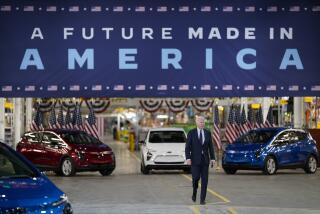A drive for clean-air rules
LOS ANGELES AND WASHINGTON — reporting from washington President Obama moved on two fronts Monday to force automakers to produce more fuel-efficient vehicles, including a major step in permitting California and other states to regulate greenhouse gas emissions.
Lawmakers and environmentalists said the president’s actions paved the way to development of a national carbon standard for automobiles.
Such a standard already is in force in Europe and Japan. Crafting a national rule would please environmentalists, but surprisingly could also satisfy the automobile industry, which has argued that trying to comply with a California greenhouse gas rule in addition to a federal mileage standard would be cumbersome and costly.
Allowing California and 13 other states to enforce the tailpipe rules could amount to a live test run for a federal greenhouse gas regulation, which would probably be written by the U.S. Environmental Protection Agency under authority granted it by the Clean Air Act, observers say.
“Today I’m announcing the first steps on our journey toward energy independence, as we develop new energy, set new fuel-efficiency standards and address greenhouse gas emissions,” said Obama, who signed an executive order asking the EPA to reevaluate a proposal by California and 13 other states to enforce their own tailpipe emissions standards. “The federal government must work with, not against, states to reduce greenhouse gas emissions.”
Obama also instructed the Department of Transportation to implement new federal fuel economy standards and touted some $90 billion in clean-energy spending in the massive stimulus bill pending in Congress, including an apparent tenfold increase in federal assistance for the development of super-efficient automobiles.
For California to regulate carbon dioxide and other greenhouse gas emissions, it needs a waiver from the EPA. In December 2007, the Bush administration refused to grant it, even though the state has received dozens of waivers over the years to regulate soot and other pollutants. The news that the Obama administration ordered the EPA to reconsider was warmly received in both Sacramento and Washington.
“Allowing California and other states to aggressively reduce their own harmful vehicle tailpipe emissions would be a historic win for clean air and for millions of Americans who want more fuel-efficient, environmentally friendly cars,” said Gov. Arnold Schwarzenegger. “It would be great to actually do this nationwide so that car manufacturers don’t just have two standards but that they only have one.”
Sen. Barbara Boxer (D-Calif.) and Rep. Henry A. Waxman (D-Beverly Hills) also released statements praising Obama’s moves.
Many of the nation’s most populous states, including New York and Florida, have embraced the California rule and have been waiting along with the Golden State for the waiver.
California state Sen. Fran Pavley (D-Agoura Hills), author of the legislation creating the California rules, indicated that Obama’s move would clear the way for a single national rule in the future.
“We have reached a tipping point where 50% of all new vehicles sold will have to meet these cleaner, more efficient car standards,” she said.
Some worry, however, that the high bar set by the California rules comes at an inopportune moment and could further damage the financially troubled U.S. auto industry, which has already thrown itself at the mercy of Washington.
Last month, the Bush administration agreed to lend General Motors Corp. and Chrysler $17.4 billion to help them survive the worst vehicle sales slump in a quarter-century. On Monday, GM announced that it would cut 2,000 jobs at two plants and halt production for several weeks at nine other U.S. factories.
“Complying with [the California rule] is yet another cash drag on these companies,” said Robert Schulz, credit analyst at Standard & Poor’s.
But in the short term, Schulz said, the automakers, and particularly the Big Three, have to make it through what is expected to be an extremely difficult year for sales. “They have to deal with other issues just in terms of survival first,” he said.
David Regan, vice president of legal affairs at the National Automobile Dealers Assn., warned of “a patchwork of state regulations that further endanger the struggling auto industry,” as well as loopholes in the California rule, and called on the White House to create a single national standard.
That view was echoed by the Alliance of Automobile Manufacturers, which represents 11 major automakers including GM, Ford Motor Co. and Toyota Motor Corp., and took the lead in a series of failed legal battles aimed at preventing California’s rules from being implemented.
“We are ready to work with the administration on developing a national approach,” said Dave McCurdy, president and chief executive of the alliance.
Such a cooperative spirit would seem to be an about-face for an industry that has opposed nearly every significant government regulation imposed on it over the last 40 years, including seat belts and catalytic converters.
“They’ve spent a lot more time and resources in fighting this than in preparing for this,” said Michelle Robinson, director of the clean vehicles program at the Union of Concerned Scientists.
Saying Obama has taken “a very different posture than the one the Bush administration took,” Robinson said she expected action on a federal standard in the near future.
The California rule requires a 30% reduction in greenhouse gas emissions by 2016 from 2002 levels, and probably even further reductions after that. One study indicates that by 2020 carmakers would have to meet a 42.5-mile-per-gallon average under the California emissions standard, compared with 35 mpg under U.S. mileage rules.
No timeline has been set for the EPA’s consideration on whether to grant California and the other states the waiver, but Stanley Young, a spokesman for California’s Air Resources Board, said it probably would take a few weeks.
Most observers agree that the waiver is almost certain to be granted.
At that point, Young said, California would be free to immediately begin implementing its rule. He said he expected that most, if not all, carmakers would be in compliance with the standard’s 2009 and 2010 requirements.
“We’ve demonstrated that all these things are already technologically feasible and many of them are already in use by the industry,” said Young, adding that the Air Board estimates the cost of compliance would amount to $1,024 per vehicle by 2016.
Conservative economists warned that car buyers would have to pay a good deal more than that in exchange for a greener policy.
“Consumers are going to get more efficient cars, but it will cost them more,” said David Kreutzer, an energy economist with the Heritage Foundation. “The upfront cost of buying a car could be $5,000 addition per car, once you consider research and development and manufacturing cost.”
Environmental groups said the rules could actually save consumers money.
Advocacy group Environment America estimated, based on California data, that tailpipe emissions standards would save Americans $93 billion at the gas pump by 2020 -- and spare the atmosphere the greenhouse emissions of a year’s worth of driving by nearly 90 million cars.
Beyond costs, some worried about whether the California standard could be effectively implemented. One common worry is that allowing California and other states to set their own standards could effectively force a GM or Toyota to sell different mixes of in New Jersey, for example, than in Connecticut.
Others fear that the California law’s system of compliance credits could be easily gamed. Such problems arose under a separate state program that required carmakers to create emission-free vehicles like battery-powered cars. In one notorious incident, Chrysler developed a fleet of glorified golf carts that it sold in the state at a discount to bank enough credits to comply.
Shortly after Obama announced the orders Monday, his secretary of State named the nation’s first special envoy to negotiate global climate-change agreements.
Emily Figdor, Environment America’s federal global warming policy director, said Obama had already done more in six days as president to combat global warming than President Bush had done in eight years. Bush rejected the idea of signing the Kyoto Protocol on global warming.
“This is long in coming,” she said, but cautioned: “We’ve taken little to no action on addressing global warming as a nation, so this is really just a first step.”
--
jtankersley@tribune.com
Christi Parsons in Washington and Marc Lifsher in Sacramento contributed to this report.






